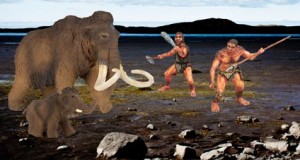Research Suggests that H. sapiens Adapted Quickly to Different Environments
If the onset of a period of deforestation resulting from climate change provided the stimulus for the evolution and development of that part of the Homo genus that would eventually give rise to our own species H. sapiens, then how did our species cope when encountering extensively forested habitats? The answer according to new research conducted by scientists from Oxford University, Sri Lanka and the University of Bradford is that our big-brained ancestors coped remarkably well.
Homo sapiens
Writing in the on-line edition of the academic journal “Science” the research team report on carbon and oxygen isotope analysis carried out on the teeth of twenty-six individuals whose remains are associated with archaeological sites in Sri Lanka that date from the Pleistocene into the Holocene Epochs. The isotope analysis provides evidence of human diet and it seems that humans as far back as 20,000 years ago were obtaining a significant proportion of their food requirements from the rainforest.
Tropical rainforest environments are nutritionally poor and their dark and often treacherous interiors are difficult to navigate. They would have represented challenging environments for human hunter/gatherers and up until now they had been little concrete evidence presented to suggest human habitation of rainforest environments prior to the advent of the Holocene, some 10,000 years ago. This new study suggests that humans were exploiting rainforests for food, rather than more open habitats at least 20,000 years ago and in the scientific paper, the research team postulate that our species could have been making a home in tropical forests perhaps as far back as 45,000 years ago.
Previous archaeological research provides “tantalising hints” that humans could have been occupying rainforest ecosystems back in the Late Pleistocene (Late Tarantian stage), although it is not clear whether these early rainforest inhabitants were seasonal visitors or whether they permanently occupied the forests.
An International Research Effort
The research represents a collaborative effort between Britain-based scientists and their counterparts from Sri Lanka (The Institute of Archaeology and the Department of Archaeology, both based in Colombo).
Commenting on the research findings, co-author Professor Julia Lee-Thorp (Oxford University) stated:
“The isotopic methodology applied in our study has already been successfully used to study how primates, including African great apes, adapt to their forest environment. However, this is the first time scientists have investigated ancient human fossils in a tropical forest context to see how our earliest ancestors survived in such a habitat.”
“Out of Africa”
If the “Out of Africa” theory of H. sapiens evolution is accepted, then it is from Africa that modern humans migrated, this migration eventually leading to the colonisation of the rest of the world. Fossils found in south-west Asia, Jordan for example, indicate a complex pattern of human and Neanderthal migrations most likely driven by climate change. From around 60,000 years ago, modern humans moved eastwards across Asia into India, south-east Asia and eventually into Australia. This migration may have taken as little as fifteen thousand years.
The scientists examined the fossilised teeth of humans from three archaeological sites in Sri Lanka, which are today surrounded by rainforest or more open terrain. The isotope analysis revealed that all of the humans in the study had a diet sourced from slightly open, “intermediate rainforest” environments, only two individuals showed signs of a diet mainly sourced from an open grassland habitat. However, the teeth that showed the “grassland signature” were dated to around 1,000 B.C. (Late Bronze Age to Early Iron Age), some of the youngest teeth used in the study.
Early Humans Exploited Different Environments
Picture credit: Everything Dinosaur
Adaptable Early Humans
This new research supports the notion of just how adaptable early, modern humans were. Back in 2011, Everything Dinosaur published an article about a remarkable discovery in East Timor that suggests as early as 40,000 years ago humans were catching Tuna.
To read this article: Prehistoric Fisherman Able to Catch Fast Swimming Tuna.
Lead author of the scientific paper, Patrick Roberts (Oxford University) explained:
“This is the first study to directly test how much early human forest foragers depended on the rainforest for their diet. The results are significant in showing that early humans in Sri Lanka were able to live almost entirely on food found in the rainforest without the need to move into other environments. Our earliest human ancestors were clearly able to successfully adapt to extreme environments.”
The rapid spread of our species across the globe after the initial out of Africa migration does seem to support the idea that early H. sapiens were extremely adaptable, although they are not the only member of the Homo genus to have made the rainforest their home. Homo erectus, was the first widespread hominin species. Fossils have been found in China and Indonesia. It is very likely that H. erectus also adapted to forested regions.
In addition, the mysterious Homo floresiensis, fossils of which come from the remote Indonesian island of Flores was very well adapted to its mostly forested island home. H. floresiensis may have survived to 13,000 years ago, but islanders talk of stories of strange little people living in the forest from much more recent times, perhaps until just a few hundred years ago.
Visit Everything Dinosaur’s user-friendly website: Everything Dinosaur.







Leave A Comment